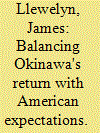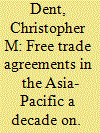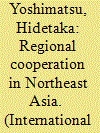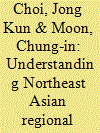|
|
|
Sort Order |
|
|
|
Items / Page
|
|
|
|
|
|
|
| Srl | Item |
| 1 |
ID:
094992


|
|
|
|
|
| Publication |
2010.
|
| Summary/Abstract |
The Vietnam War greatly destabilized Southeast Asia and led to almost a decade of fighting by America and its Asian allies. It was fought on the principle that if communism was unchecked it would overrun the region, with the Southeast Asian countries falling under communist control like 'dominoes'. While countries such as Thailand, South Korea, and Australia provided military support to assist American strategic objectives, Japan, however, was constrained by its peace constitution and thus unable to provide direct military assistance. Nonetheless, under the leadership of the avid anti-communist conservative leadership of Prime Minister Eisaku Sato, Japan still managed to play a role in the Vietnam War. Although Japan initially entertained the notion of facilitating mediation, with Okinawa's reversion hanging in the balance after 1967, Japan's leadership took a more hawkish approach on Vietnam in order to ensure that Washington would agree to reverting Okinawa to Japanese administrative control.
|
|
|
|
|
|
|
|
|
|
|
|
|
|
|
|
| 2 |
ID:
094989


|
|
|
|
|
| Publication |
2010.
|
| Summary/Abstract |
This paper charts the growth and patterns of free trade agreement (FTA) activity in the Asia-Pacific, discussing the extent to which there has been evolution and learning in FTA practice among Asia-Pacific states, with attention to the most notable trends in technical policy content and the different ideational approaches to formulating agreements. This sets the broad context for considerations of the current and likely future paths of FTA convergence, harmonization, and transformation in the Asia-Pacific. It is argued that new options for economically rational and politically feasible bilateral FTA partnerships within the Asia-Pacific region are running out. One response has been to explore more seriously options for forming wider plurilateral and regional agreements within the Asia-Pacific. However, a number of constraints and hindrances will work against such FTA convergence and harmonization. The longer term transformation of existing, mostly bilateral FTAs into different or expanded types of agreement has stronger prospects.
|
|
|
|
|
|
|
|
|
|
|
|
|
|
|
|
| 3 |
ID:
094991


|
|
|
|
|
| Publication |
2010.
|
| Summary/Abstract |
As states jostle to attract and entice others by deploying a range of innovative strategies, a 'soft' power competition era looms possibly in the Asia-Pacific. This paper argues that reflecting on this period of competitive policy innovation provides a valuable opportunity to re-assess the theory and practice of Joseph Nye's 'soft' power, given its conceptual and empirical frailties: how theoretically precise are the policies commonly described as projecting 'soft' power? To do so, it undertakes a comparative evaluation of Japan's and China's 'soft' power strategies. By paying close attention to the theory-practice linkage, it illuminates the disparities in their understanding of Nye's 'soft' power. Rather than a one-size-fits-all concept, 'soft' power strategies with distinctively Japanese and Chinese characteristics are emerging, bringing different advantages and weaknesses. The proverbial magic mirror would conclude that by more closely matching Nye's formulations and displaying a less competitive streak, Japan appears the 'softer' power.
|
|
|
|
|
|
|
|
|
|
|
|
|
|
|
|
| 4 |
ID:
094990


|
|
|
|
|
| Publication |
2010.
|
| Summary/Abstract |
Since the late 1990s, China, Japan, and South Korea - the core states in Northeast Asia - have gradually engaged in various initiatives and institutions for regional cooperation. Such initiatives extend from summitry to functional cooperation in finance, environmental protection, logistics, and other areas. Furthermore, the three countries have shown their willingness to vitalize cross-border economic activities by concluding commercial arrangements. Given these evolutions, this article seeks to address the following questions: what features are found in trilateral cooperative initiatives and how these features are evaluated in terms of 'regional governance'? The paper advances two propositions. First, regional cooperation in Northeast Asia can be characterized as weak neoliberal orientation and intensive business involvements in cooperative projects in state-directed policy networks. Second, regional governance in Northeast Asia has gradually intensified the nature of regulatory governance in which the governments of the three countries sought to harmonize standards and regulatory systems through trilateral cooperation.
|
|
|
|
|
|
|
|
|
|
|
|
|
|
|
|
| 5 |
ID:
094993


|
|
|
|
|
| Publication |
2010.
|
| Summary/Abstract |
Northeast Asia has emerged as the center of gravity in contemporary international relations (IR), partly owing to China's rise, over the past two decades. In understanding regional dynamics in Northeast Asia, the (neo-) realist perspective has been dominant. Despite its rich analytical and empirical contribution, however, preoccupation with power and its distribution, blurred geographic focus, and built-in status quo bias have prevented the existing realist literature to capture the new reality of the region that can be characterized by trends toward liberal transition, the politics of national identity, and growing correlates of perception, domestic politics, and regional interactions. Against this backdrop, we attempt to undertake an inventory checking of new discourses on power, interest, and identity in accounting for regional change and stability as well as to shed new light on debates on theorizing of IR in Northeast Asia.
|
|
|
|
|
|
|
|
|
|
|
|
|
|
|
|
|
|
|
|
|